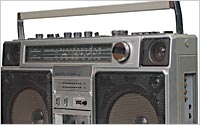Fitch: Trad Radio Holds, Digital Poses Threats But Less Revs
- by Erik Sass @eriksass1, March 9, 2012

The next few years will not revitalize the stagnant radio industry, according to Fitch Ratings, which sees annual revenue declines in the 1%-2% range. However, the company’s analysis holds out hope for digital revenue growth in the long term.
In the near term, radio faces a number of threats in the evolving media landscape. Most prominently, Fitch warned that “new Internet and mobile entrants will reduce time spent listening” at a rate of 3% to 4% per year.
Moreover, while traditional radio broadcasters’ digital initiatives could capture “a sizable portion of digital listening,” Fitch does not expect their digital efforts to produce significant revenue for another year or two.
advertisement
advertisement
Still, Fitch cited some reasons for optimism, noting that radio’s “audience reach should not decline substantially,” and predicting that advertiser demand will remain, “given the large core audience, the medium’s local reach, its targeted nature, and its low cost.”
Digital competitors face significant hurdles to achieving a size and scale that will allow them to present serious competition to radio. Assuming that the overall economic situation does not decline, Fitch predicts radio ad pricing to increase at the rate of 1%-2% per year.
Fitch noted that radio has a couple of advantages as it attempts to transition to digital. Most notably, continuing high profit margins mean radio broadcasters will have the funds to invest in digital platforms, even if lenders and investors are wary of the medium.
At the same time, Fitch observed that HD radio, long touted as broadcast radio’s digital savior, has not taken off due to low awareness among consumers and high conversion costs for radio stations. Broadcasters have also failed to take advantage of the multicasting capability for HD radio. Given these trends, Fitch does not expect HD radio to develop any momentum, as it has been effectively bypassed by the Internet and other digital platforms.



Couple of issues:
1) Most Radio Broadcasters high profits are being used to service their debt which was racked up during the early half of the 2000's when all of the big players were making leveraged land grabs. This limits the opportunity to invest in growth. After the bankruptcy filings of several major broadcasters the companies servicing this debt have shortened the leash.
2) Culturally radio stations cannot change models. This is the same issue which has destroyed the local newspaper industry and contributed (among other factors) to the total collapse of yellow page organizations.
3) Radios digital revenues (similar to print) are shell games at the moment. Stations slide revenue into the "new media column" and give away the "old media" for free. Problem is the new media doesn't have enough scale to work. So the advertiser gets turned off permanently to the new media offering and will only purchase as long as the old product is giving some semblance of returns.
Best hope for radio is to scrap down to the bare bones their operating costs and run the organization like an annuity... something that will pay out until death. This is also know as the Cumulus media model.